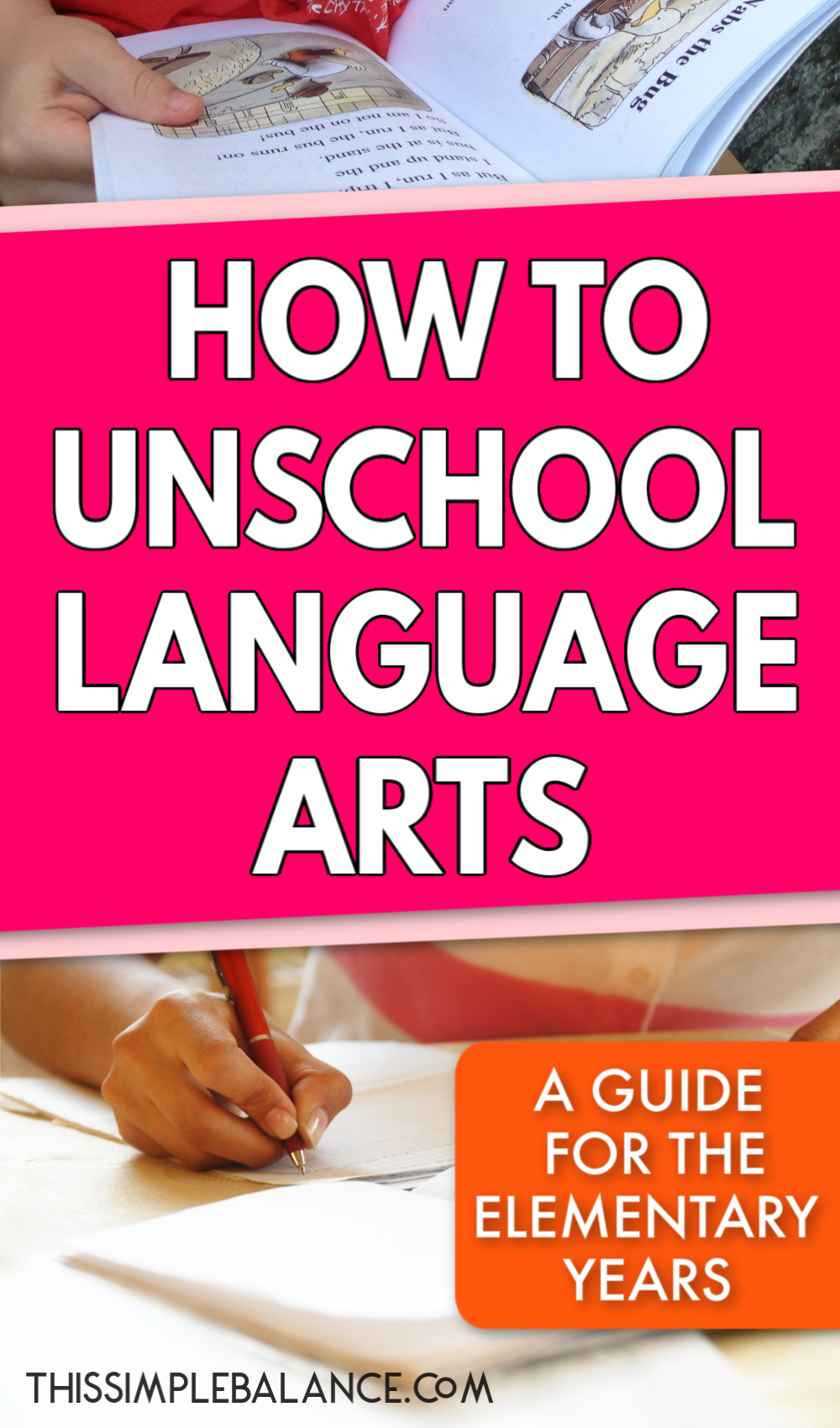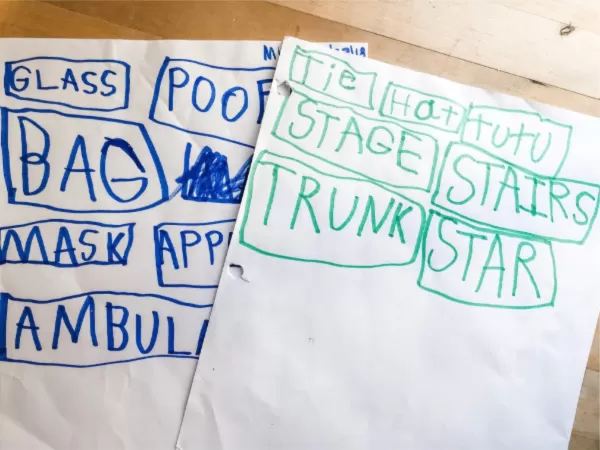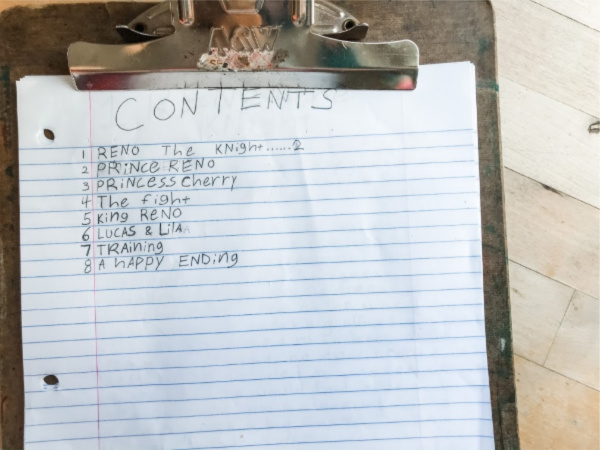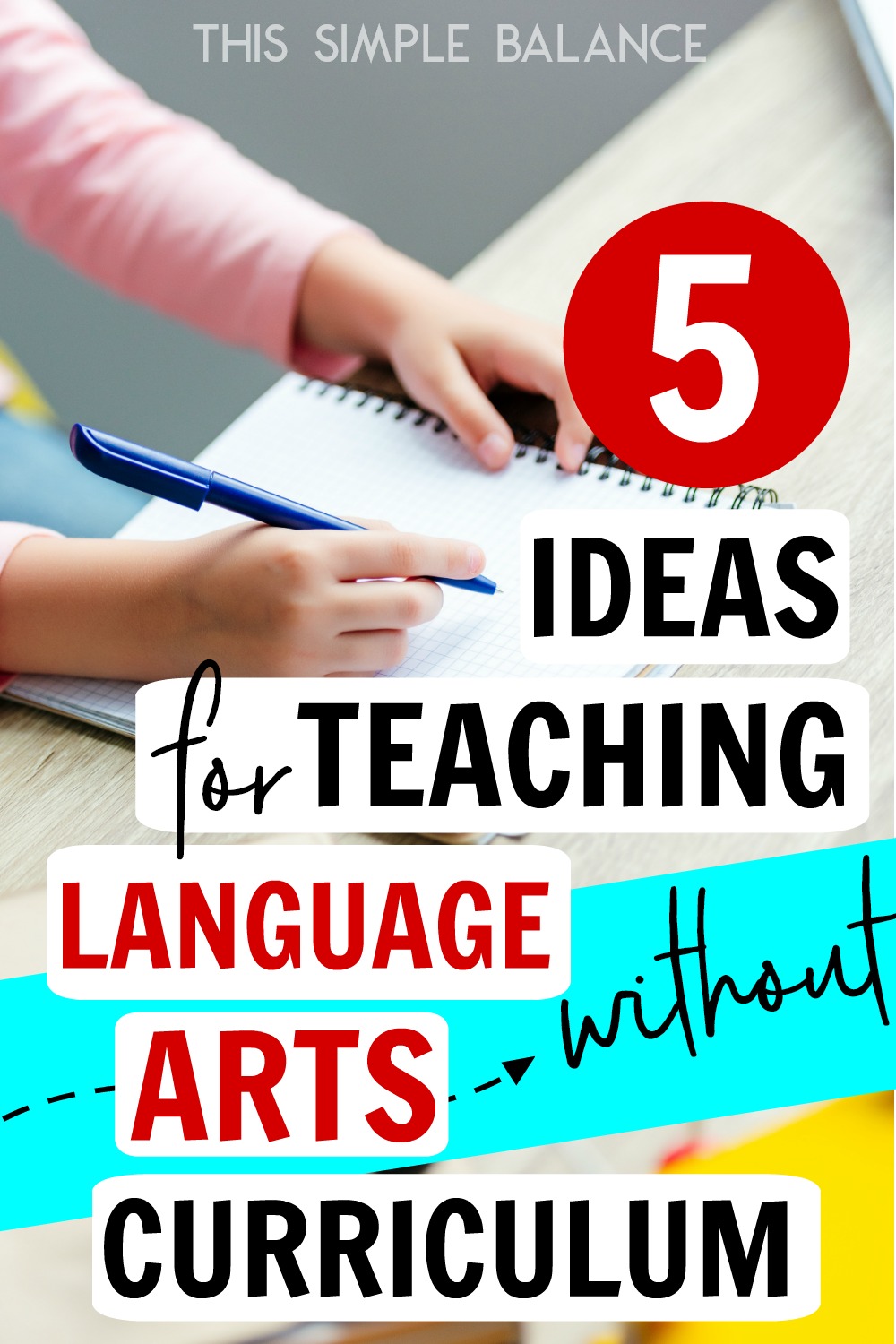Inside: Unschooling language arts can feel intimidating. Reading and writing are arguably THE most essential skills our kids can have today. Learn the key elements for successfully unschooling language arts, as well as our family’s personal experience using unschooling methods with three elementary-aged children for both reading and writing.
I came into the room where my then 6-year-old daughter was supposed to be finishing a single page of her phonics workbook.
One page. That’s all I’d asked of her.
Forty-five minutes had passed. More than enough time to complete the assignment.
But when I looked down at her page…it was blank. There wasn’t a single answer filled out.
She literally stared out the window for close to an hour instead of doing the phonics workbook she said she hated.
She was committed. I’ll give her that.
That was my first clue that traditional language arts homeschool curriculums and workbooks weren’t going to work for us.
That’s when I decided to let go of the way I was taught language arts, and my unschooling language arts experiment began.
Related: The 12 Best Unschooling Books for Rethinking Education
Am I really qualified to talk about unschooling language arts?
THIS POST PROBABLY CONTAINS AFFILIATE LINKS. AS AN AMAZON ASSOCIATE, I EARN FROM QUALIFYING PURCHASES. YOU CAN READ OUR FULL DISCLOSURE POLICY HERE.
Before I start talking about unschooling language arts, you should know that I’m not a pure unschooler…technically speaking. I’m definitely not a radical unschooler.
(Update: Turns out I am actually a radical unschooler. We transitioned fully to unschooling for the 2021-2022 school year. You can find our unschooling plans for 2022-2023 HERE.)
I consider myself a relaxed homeschooler (mostly because I don’t love how the unschooling label makes peoples’ eyes glaze over, or alternatively, makes unschoolers question your legitimacy using that label).
There are things I do want my kids to know, and believe they need to know, to be successful adults.
I do a LOT of strewing – sharing my own passions with them, buying things I think will interest them. While I give them permission to opt out of activities I suggest, I still do suggest them.
Where language arts is concerned, we do very little formal language arts instruction or use formal language arts curriculum.
We don’t do spelling lists or grammar exercises (unless my kids decide to do the language arts section of their Brain Quest workbooks) or structured writing assignments.
So am I qualified to talk about unschooling language arts? Maybe. Maybe not.
But I’m going to share our experiences anyway.
You Might Also Like: Unschooling vs. Homeschooling – What’s the Difference?

5 Essentials for Successfully Unschooling Language Arts
In my experience, there are a few essential ingredients for unschooling language arts.
1. A Language-Rich Home Environment
Is your home full of written language?
Are there magnet letters on your refrigerator waiting to be made into words? (or whole magnet words)
Are there books on your bookshelves, signs on your walls?
Do you enjoy playing with language? Are there language arts board games on your shelves and word puzzles in your home?
If your child is growing up in a home where words are everywhere, he will inevitably want to learn how to read and write.
2. A Read-aloud Family Culture
Reading aloud is an essential part of any homeschool, but especially an unschooling homeschool.
Unsure of where to start? These books can help and offer suggestions of quality read-alouds:
Stories are the bread and butter of childhood. They aren’t optional – children NEED stories.
Stories are where children learn empathy and inspiration and perseverance. It’s where they learn cultural references, norms and idioms.
My kids learn geography and history and science and even math through our read-alouds.
I’m convinced if you did nothing else in your homeschool, reading aloud would be enough.
Related: Unschooling Science – 8 Easy Ways to Nurture Your Child’s Natural Curiosity
3. Trust and Patience
This is perhaps the most difficult part of unschooling language arts – the waiting. Some kids surprise us!
Like my oldest, they are eager to learn how to read before the age of five. It’s easy.
Others, they can be 7, 8 or 9 and not show any interest whatsoever.
Personally, I am not of the radical unschooling mindset that you always need to sit back and wait for them to express interest. I do initiate with my kids, asking if they want to learn how to read. But I respect their “no” if that’s the answer I receive.
Waiting is hard because you just don’t know when the desire to learn how to read will come. It’s nail-biting, especially if the waiting stretches well beyond when they are “supposed” to be reading.
Letting go of the traditional school benchmarks is a major part of unschooling and homeschooling in general.
On the other side, however, you need to also trust your gut when you believe something might be wrong.
If your child wants to read but struggles to learn no matter what method you try, she may need to be evaluated to rule out learning disabilities.
4. An Adult Who Reads and Writes
In order for your child to be motivated to learn how to read and write, YOU need to be reading and writing in front of your child.
Ideally, your child should see you reading physical books or a kindle. If you are reading via the kindle app on your phone, your child doesn’t realize you’re doing anything other than looking at your phone.
Do you show a need for writing?
I have a slight advantage in that I earn a living through my writing.
But you can easily show a need for writing through making lists, writing e-mails (tell your child what you’re doing), filling out forms, etc.
5. Willingness to Help with Reading and Writing When Your Child is Ready
I hesitate to say “teach” reading because I don’t believe that learning how to read is as complicated as schools and reading instructors make it out to be.
I also no longer believe that phonics is a fail-proof system for learning how to read, either.
Just like with spelling, there are far too many exceptions to make it worth my while to teach rules beyond the basics (e.g. short “a” says short “a” and “ee” usually indicates a long “e” sound).
Learning to read takes practice with an adult who knows how to read, plain and simple. Some kids require more practice than others to become confident readers.
I’ll talk more about writing later on, but your child will need similar support with learning how to write and for writing down her thoughts and stories when the time comes.
Related: 5 Popular Homeschool Reading Curriculums (& how to choose)

Unschooling Reading
How did my kids learn how to read?
My 10-year-old
My daughter was itching to read just before she turned five. I was too overwhelmed to figure out how to teach her (which I thought I had to do), so I immediately signed her up for a university model school where she spent half the time at school and half the time at home.
It was there that she learned to read through some basic phonics instruction.
We withdrew her from the school at the end of that year and continued homeschooling on our own. I didn’t do any additional reading instruction after that initial phonics instruction.
She just took off reading – no more teaching necessary.
My Now 8-year-old
My son was my first experience with how unschoolers approach reading. He was six and still had no interest in learning how to read.
What he did have an interest in was Word World, the PBS show where all characters and pictures are composed of letters.
He watched it every single day, and he faithfully wrote down all the words covered in each episode on paper. He loved writing those words down.
He kept them all in a binder and went over them again and again and again.
I offered to teach him to read. He even enjoyed reading with me for a little while…until he got bored. Until every single reading session was like pulling teeth.
That’s when I backed off. I decided to trust the process, to believe that when he NEEDED to read, he would learn.
It was weeks. Then it was months.
He continued to read here and there. He would surprise me by knowing certain words I didn’t know he knew.
Then one day when he was close to 7.5, I almost fell over when he came to ME. He said, “Mom, I’m ready to practice reading with you again.”
It was all him. Every day, he came to me with the reading books, asking to read.
You see, he finally felt the need – the need to know how to read.
His sister could read effortlessly. She could play the video games he wanted to play. She could read signs and words on movies he wanted to read.
He needed to learn how to read, so he did.
He flew through those books with flying colors. There was a lull, and then we discovered the Dog Man books. He wanted to be able to read those books, so we sat together and read through the entire Dog Man series.
Can you learn to read without phonics?
Unlike his sister who took well to phonics instruction while at school and decodes words easily using that very little phonics instruction, my son was a whole language learner from the start.
Sure I gave him some phonics instruction while we worked through these reading books, but largely, he memorized whole words all the time.
Once he knows a word, he knows it. It does mean he needs more one-on-one reading practice with me, but it’s clearly how he learns.
I used to believe whole-heartedly in phonics….until I realized that so many words don’t follow the rules.
I realized that while phonics CAN help with decoding new words, it doesn’t always help. Phonics is NOT the end all be all for reading.
However a child learns to read best is how he learns to read best. Plain and simple.
When you’re unschooling language arts, you really need to forget how the experts say kids SHOULD learn how to read. You need to observe the child in front of you and how he IS learning how to read.
How does he respond to phonics instruction? Does it make sense to him? Does he learn the rules quickly and apply them?
Or does he seem to memorize whole words? Knowing a combination of some simple words and other complex words could indicate a preference for whole language learning.
You might have a whole language learner on your hands.
My 6-year-old
My newest reader, who just turned six, is one who seemed extremely eager to learn how to read. I flat out asked him if he wanted to start learning this school year.
He said, “Yes,” so we’ve been working through the same books his brother finished just a few months before. I’m committed to letting him off the hook if he loses interest, but he’s pretty determined still.
When will your child want to learn how to read?
Peter Gray, Psychology Professor at Boston College and unschooling advocate, studied unschoolers learning how to read, particularly interested in what age they learned how to read.
The stories sent to me by readers of this blog include 21 separate cases of children learning to read in which the age of first real reading (reading and understanding of novel passages of text) was mentioned. Of these, two learned at age 4, seven learned at age 5 or 6, six learned at age 7 or 8, five learned at age 9 or 10, and one learned at age 11. (source)
Sometimes, as with my oldest, kids just want to learn how to read at a young age.
They get a tiny bit of reading instruction, growing into a fluent reader seemingly overnight. They don’t need any more help.
Other kids want and need to work with you on a regular basis to become a fluent reader. If your child expresses a desire to learn how to read, your job is to remind them of that and offer to work with them every day on their goal.
You can choose a complex reading curriculum, but I’ve personally found that the simpler, the better. I love these books because they work on specific groups of sounds, the stories are actually funny
If it becomes like pulling teeth, take a break and come back to it later when your child initiates or shows interest.
Related: Learning to Read is a Natural Process…If You’re Willing to be Patient

Unschooling Writing
The Physical Act of Writing is Hard
When you establish and read-aloud family culture and create a language-rich home environment, kids often naturally want to write their own stories (though there exceptions, of course). They often want to share stories before they can physically do so.
Have you tried writing multiple sentences by hand lately? If not, try it right now.
Writing is HARD work! Even for adults who know how to write!
Your kids will have stories to tell long before they have the stamina or mechanics to write them down at the speed they come up with them in their heads. Your job before they can write more than a few words, or even sentences, on their own is to be their scribe.
The mechanics of writing will come eventually, with time and practice. Even my oldest who loves to write stories gets tired from writing (and so do I, for that matter).
The sooner she can learn how to type, the better!
The Biggest Problem with Writing Instruction Today (& Why I Approach Writing the Way I Do)
I believe that most writing instruction today is backwards: teaching the mechanics first and foremost, with no focus on having a message to share (writing paragraphs about what you did over the weekend doesn’t count if your child doesn’t see it as meaningful or relevant).
My biggest focus during the elementary school years is to help them tell their stories and reinforce the message that they have something worth telling.
What does it matter if you can spell with the best of them or spot a grammatical error a mile away but you have nothing to write about? No message worth sharing?
Whatever writing mechanics instruction I give happens at my child’s initiation or in the context of actually writing something meaningful.
There is no assigned copywork in our homeschool (although my kids will occasionally initiate copywork themselves), no spelling lists, no sentences written just to learn a particular grammar principle or to practice writing mechanics.
I did pick up a copy of Daily Grams last year because my daughter said she wanted to work on grammar after completing a standardized test. But we both found it so dry and repetitive, I can’t say I’d recommend it.
We occasionally dabble in spelling tests with grade-appropriate spelling words (someone somewhere decided these particular words were 4th grade word – eye roll) just because my daughter enjoys seeing what she knows and getting a “grade”.
We’ve also tried Brave Writer Arrow Guides.
Related: An Honest Brave Writer Review from a Former Skeptic
They were definitely filled with interesting and useful content, but they simply didn’t fit our relaxed homeschooling lifestyle. Also interesting to note, when we tried it, my oldest asked, “So why are doing this again?”
Kids are pretty smart. They see right through things, even if they are disguised in fun and enchantment.
I’ve found that you really can learn all the mechanics of writing – spelling, handwriting, grammar, varying sentence structure – in the context of meaningful, self-directed writing.
So why use rote instruction and workbooks unless your child specifically asks for them?
How do unschoolers learn how to write?
My kids see me writing all the time, and I offer to scribe for them regularly (they are free to decline). We also make space in our daily rhythm for writing.
For you, that could look like project time in the mornings or afternoons, an idea I picked up from this unschooling blogger. You can call it what you want, as long as your child knows during that time you are available to help with whatever project they want to work on, including writing.
When they’re little, kids often want to write simple letters at the table, often in the context of art projects.
I keep Wipe Clean handwriting books like THIS one on hand and offer them occasionally because they’re a fun way to practice writing. But it’s never something they “have” to do.
Two of my three older kids consistently initiate writing on their own, whether that’s writing stories, “reports” or letters to friends or family.
Because my oldest loves writing stories, we are also trying THIS Write Your Own Storybook from Usborne.
My 8-year-old doesn’t appear to have a strong need for writing just yet, beyond copying down the occasional recipe. He also claims it’s difficult and tedious for him, even though he does have decent handwriting.
He prefers to spend his time watching science shows, baking and working with wood. We also enjoys playing a typing game regularly.
I trust that he will eventually write (or type) when he needs to write.
In the meaning, we read aloud a lot, play language arts board games, and do word games like these crossword puzzles together.
Common Fears & Concerns with Unschooling Writing
Q: My child’s spelling is atrocious.
My daughter couldn’t spell worth a darn at age 7. I was honestly fearful she would never learn how to spell properly.
But then in the span of just a few months between ages eight and nine, her spelling dramatically improved. I’m not sure if it was writing more stories or reading more. But something clicked and she could suddenly spell.
Most children are either natural spellers or not natural spellers.
I’ve seen other homeschoolers start spelling instruction in middle school if they can see their child is obviously NOT a natural speller. This is an option if you want to take a more traditional school approach to writing later on.
Personally I prefer to practice spelling through games and meaningful writing instead of using a spelling program. Spellcheck and Grammarly are wonderful tools as your child gets older!
Related: Unschooling Spelling Works – How Kids Learn to Spell Without School
Q: My child never wants to write.
If your child never wants to write, my first questions would be, “Do YOU write?”
If your child sees no obvious need for writing, they may not initiate writing on their own.
So if you are wanting to continue to approach writing using an unschooling approach, you may need to step up your own writing game at home – lists, copying down quotes you love, starting a blog.
Whatever you do make sure your child can see you writing. Eventually, I am confident they WILL see a need and start writing, whether that’s lists or stories or “reports” (sharing information they’ve learned) or e-mails or online chats.
Q: Should I edit my child’s writing?
Personally, I don’t like other people editing my own writing without me asking them to. I try to give the same courtesy to my children.
I always ask when I’m reading their work, “Do you want me to fix things?” They can say, “Yes” or “No”.
My daughter now asks for my editing and takes some of my suggestions for stylistic improvements (after getting her approval to make those suggestions).
I can speak from experience that my first blog posts are horrible. Only by writing post after post after post and by reading other bloggers’ blog posts did my writing improve.
I am confident that as my kids continue to write, they will naturally improve and have a desire to improve.
Q: Don’t my kids need to learn how to write academic papers?
If they want to go to college, yes.
But this unschooling book convinced me that if there is a true need (they want to get a specific college degree and need certain courses to do it), and you teach your kids how to learn and give them a passion for reading and writing, they can easily pick up the skills they need to write for college courses.
You Might Also Like: Why a Former Teacher Decided to Unschool Her Own Children
Final Thoughts on Unschooling Language Arts
I can’t speak to unschooling language arts beyond the stage I am currently in (my oldest is technically still in the fourth grade). There are several books written by homeschooling/unschooling moms beyond the stage I’m in who can speak to that.
For me personally, I learned how to read before I entered school, and I’ve been a reader ever since. Both of my parents are readers, so I am sure I would have been an avid reader with or without school.
I learned HOW to write “well” in school but always thought I hated writing. It wasn’t until I had a reason to write (this blog, to earn money from home) that I realized I actually enjoyed writing about the things I cared about.
I actually had to UNLEARN my stilted and formal, academic-style, writing in order to make a living writing online.
That’s why I approach language arts the way I do: because I strongly believe you need to have a reason to write before you can learn HOW to write. You can learn writing mechanics as you go because you have a NEED to learn them to get your message across.
Like everything else in relaxed homeschooling, if teach your kids how to learn and give them the freedom to pursue their natural curiosity and passions, they will rise to the challenge in every subject area.
And language arts is no exception.
Read Next: The Best Unschooling Podcasts to Listen to This Year


